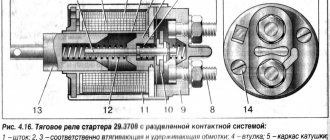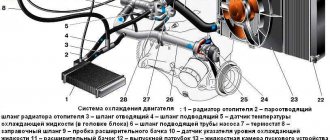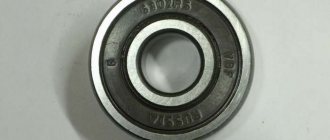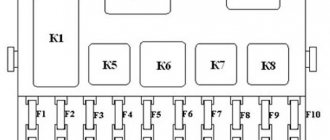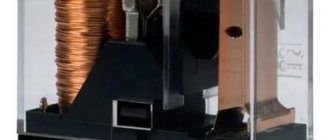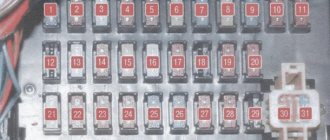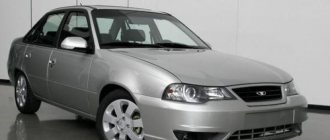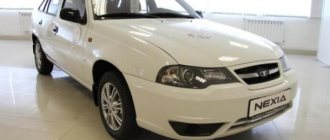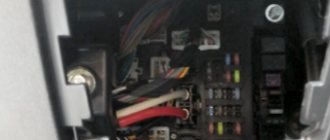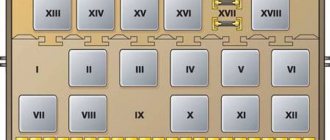The Daewoo Nexia sedan is equipped with an electrical system with a negative contact (“ground”) to the car body. The standard voltage of the on-board network is 12 volts.
To protect the electrical equipment of the machine from short circuits or overloads, the main circuits are protected by fuses.
Nexia with an 8-valve engine and a 16-valve modification have identical electrical circuits.
The way fuses work is to open the electrical connection if a certain current is exceeded. In the event of an emergency electrical situation, the current-carrying fuse element is destroyed (blown), protecting electrical units from breakdown, and the car itself from possible fire.
Nexia uses flat blade (fork) type fuses, standard ATO size, 19 mm high. The rated current in amperes is marked on the top surface of each fuse. For ease of identification, fuses of different ratings have a specific body color, but not all manufacturers follow this rule.
Main fuses for Daewoo Nexia
The main set of fuses is located in the Daewoo Nexia mounting block. The block is located at the bottom of the instrument panel, on the left side of the steering column. On the outside, the fuse box is covered with a plastic decorative cover. For the convenience of the driver, the location diagram and purpose of fuses and electromagnetic relays are indicated on the inner surface of the cover, and the seats on the board are numbered.
Control and security:
| Fuse no. | Functionality of the electrical circuit | Maximum current |
| F1 | Powering the ECU from the battery | 10 amps |
| F3 | Electronic ignition unit | 10 amps |
| F7 | Power supply to the fuel pump and fuel injection nozzles | 30 amps |
| F10 | Immobilizer, ABS system, fuel tank flap drive | 10 amps |
| F13 | Generator, instrument panel, horn, cigarette lighter power supply | 20 amps |
| F12 | Power supply to the cooling fan motor (low speed) | 30 amps |
| F14 | Main radiator fan motor power supply (high speed), horn | 230 amps |
Lighting devices:
| Fuse no. | Functionality of the electrical circuit | Maximum current |
| F2 | Side lamps and rear room lights | 10 amps |
| F4 | High beam bulbs for front headlights | 20 amps |
| F5 | Low beam bulb, light direction corrector (left headlight) | 10 amps |
| F6 | Low beam bulb, light direction corrector (right headlight) | 10 amps |
| F8 | Turn signals, hazard warning lights, brake lights | 20 amps |
| F13 | Reversing light | 20 amps |
| F15 | Interior lighting, trunk light, dashboard clock | 20 amps |
| F20 | Standard fog lights (located on the back of the fuse box) | 30 amps |
Climate and multimedia devices:
| Fuse no. | Functionality of the electrical circuit | Maximum current |
| F9 | Electric windshield wipers | 30 amps |
| F11 | Activating the air conditioning compressor | 10 amps |
| F16 | Electric door window drives | 30 amps |
| F17 | Radio control (from the ignition switch) | 10 amps |
| F18 | Car radio power supply (from battery), electric trunk lid lock, rear window heating system, central door locking wiring | 30 amps |
| F19 | Power supply to the heater fan (located on the inside of the fuse box) | 30 amps |
Fuse and relay diagram for Daewoo Nexia 1 N100 and 1 N150 in the cabin
| Relay no. | Relay purpose | Relay marking |
| 1 | Cooling Fan Motor (High Speed) | 90244312U |
| 2 | Direction indicators | 96312545U (495.3747-01) |
| 3 | Fuel pump | 90191753U |
| 4 | Fog lights | 90244312U |
| 5 | Lighting devices | 90229206U |
| 6 | Headlights | 90229206U |
| 7 | Cooling fan motor (low speed) | 90229206U |
| 8 | Air conditioning compressor | 90229206U |
| 9 | Sound signal | 90229206U |
| 10 | Warning buzzer | 96208850 |
| 11 | Heater fan motor | 90244312U |
| 12 | Wiper speed control | 94788146 |
| 13 | Heated rear window timer | 96116223 |
Circuit breakers
| Fuse no. | Fuse color | Protected target | Amperage, current A |
| F1 | red | Electronic engine control unit (battery circuit) | 10 |
| F2 | red | Side lights, license plate lights | 10 |
| F3 | red | Airbag (if equipped) | 10 |
| F4 | yellow | High beam lamps in headlights | 20 |
| F5 | red | Low beam lamp and electric corrector (if installed) of the left headlight | 10 |
| F6 | red | Low beam lamp and electric corrector (if installed) of the right headlight | 10 |
| F7 | green | Fuel pump, injectors | 30 |
| F8 | yellow | Turn signal lights, hazard lights, brake lights, anti-lock brake system (ABS) (if equipped) | 20 |
| F9 | green | Windshield wiper and washer | 20 |
| F10 | red | Electric fuel tank filler hatch cover, ABS (if the system is installed) | 10 |
| F11 | red | Air conditioning compressor activation relay (if air conditioning is installed) | 10 |
| F12 | green | Cooling fan motor (low speed) | 30 |
| F13 | yellow | Instrument cluster, clock, cigarette lighter, warning buzzer, alternator, reverse lights, heated rear window switch and relay | 20 |
| F14 | green | Cooling Fan Motor (High Speed), Horn | 30 |
| F15 | green | Interior lamp, clock, trunk lamp, electric antenna (if installed) | 30 |
| F16 | red | Power windows (if equipped) | 10 |
| F17 | red | Car radio (target from ignition switch) | 10 |
| F18 | green | Car radio (battery circuit), electric trunk lock, heated rear window, door lock system (if installed) | 30 |
| F19 | green | Heater fan motor | 30 |
| F20 | green | Fog lights | 30 |
The cigarette lighter fuse in Daewoo Nexia 1 N100 and 1 N150 cars is designated under number F13.
Additional fuses for Daewoo Nexia
Nexia owners often equip their car with additional electrical equipment that is not installed as standard. When properly installed and connected, such devices are protected by additional fuses and relays directly in their electrical wiring.
So, for additional lighting devices and DRLs, the fuses are typically located in the engine compartment or under the dashboard. The electrical components of the seat heating system are most often located in the passenger compartment and to access them you need to disassemble the lower part of the center console or remove the tunnel lining in the area of the gearshift lever.
It should be remembered that connecting a large number of additional energy consumers can negatively affect battery charging and the operation of the machine's electrical system.
Fuse box in Nexia
Fuses on Nexia are responsible for the safety of electrical appliances. When a short circuit occurs, the fuse burns out first, thereby protecting the electrical appliance. The fuse box diagram for Nexia 8kl and 16kl are identical and for Nexia n100 and n150 the blocks are also interchangeable. Every self-respecting motorist should have such a diagram at hand. Also, replacing fuses should be done with the engine turned off. The Nexia has a double fuse box; the main fuses and relays are located on the outer visible side, and the remaining relays are located on the reverse side.
To differentiate between each other, fuses come in several colors. Each color has an amp rating.
Red – 10 Amps Blue – 15 Amps Yellow – 20 Amps Green – 30 Amps
Control relays for Daewoo Nexia electrical system
Activation of automotive equipment with a high load current (starter, radiator fan, generator) is performed through electromagnetic relays. In Daewoo Nexia, the main control relays are also located in the mounting block:
| Relay no. | Purpose | Marking | Installation location |
| K1 | Radiator fan motor control (high speed) | 90244312U | External side of the fuse box |
| K2 | Turn signal control | 96312545 U (495.3747-01) | |
| K3 | Fuel pump activation | 90191753U | |
| K4 | Front and rear PTF | 90244312U | |
| K5 | Side lights | 90229206 U | Inside of the fuse box |
| K6 | Front headlights | 90229206 U | |
| K7 | Radiator fan motor control (low speed) | 90229206 U | |
| K8 | Air conditioning compressor control | 90229206 U | |
| K9 | Horn activation | 90229206 U | |
| K10 | Low beam headlights (when high beams are on) | 90229206 U | |
| K11 | Warning signal (buzzer) | 96208850 | |
| K12 | Heater impeller motor control | 90244312U | |
| K13 | Activating the ignition system | 90244312U | |
| K14 | Adjusting the windshield wiper speed | 94788146 | |
| K15 | Rear window heating activation timer | 96116223 |
Removal and replacement process
If you need to replace a fuse, remember that you should use a new element of the same power as the burned one.
Of course, fuses are interchangeable with each other, however, keep in mind the fact that different circuits in your car's wiring require different protection. If you don’t know what power the burnt-out element has, then just look at it: there are numbers on the part, this is the power.
Vehicle Daewoo Nexia
If you recently replaced the element, but it burned out again almost immediately, this may be due to a short circuit. First, you need to eliminate the cause itself, that is, check the section of the wiring for which the relay or fuse is responsible, and get rid of it. In practice, usually the main reasons for the systematic failure of elements is a broken or worn-out wire. Therefore, before replacing the element, it would be better to replace it.
Also, refrain from installing homemade devices. Very often, motorists make such mistakes, but such actions do not lead to anything good. So, let's start replacing the fuses.
Rules for replacing fuses
To replace a blown fuse or a failed relay, you need to de-energize the corresponding circuit of the vehicle's electrical system (turn off the ignition or remove the terminal from the battery), open the mounting block and remove the faulty part from the terminals. For ease of use, some sets of fuses are equipped with special plastic pliers that facilitate dismantling.
You also need to remember a few rules that will help avoid damage to the electrical system of the Daewoo Nexia:
- Do not use fuses with a higher current rating than specified in the instruction manual. This can cause burnout of contact tracks on the printed circuit board of the unit, breakdown of final energy consumers, and even fire of the car.
- It is strictly forbidden to replace fuses with metal jumpers or short-circuit the legs of burnt fuses with wire.
- You should not save on buying fuses, since products of dubious quality from the lower price range often do not correspond to the rating indicated on the case and, therefore, do not perform a protective function.
Daewoo Nexia › Logbook › Nexia does not turn the starter - SOLVED (ALARM)!
Hi all! I need help identifying the breakdown, I’ll write what I’ve already done: I started the car from autostart (alligator s825), drove it, turned it off. I start it with the key, the starter does not turn. I try autostart, the ignition turns on, the starter does not turn. In the cabin, the relay clicks when you try to turn the starter (possibly in the alarm system). No clicks are heard from under the hood. I googled it, checked the battery terminals, everything is fine, reset them, no result. I checked the KG, when you turn the key to the starter, +12 appears on the purple wire. I checked the 30A voltages at the signaling, they are normal. I haven’t checked the lilac wire that controls the starter yet; there should be a + on it when trying to autostart, or just from the key. I couldn't find a fuse on this lilac wire. It may be a coincidence that the problem appeared as soon as it got colder. I tried to close the contacts on the starter, but it didn’t work, or I closed it the wrong way. It’s inconvenient to get there... Tell me what could be wrong, and how to close the starter directly?
PROBLEM SOLVED! I DECIDED TO CLOSED THE CONTACTS ON THE RETRACTER WITH A SCREWDRIVER, AN EXPERIENCED GUY DRIVED UP IN A NEXIA N100, SHOWED WHERE TO LOCK IT, IT STARTED. HE RECOMMENDED LOOKING FOR AN BREAKDOWN TO THE CONTROL WIRE WITH A PULL-IN RELAY. IT IS CONTROLLED BY A SIGNAL. IT TURNS OUT THAT THERE WAS A + OR NOT ON IT (THICK LILAC WIRE FROM THE POWER CONNECTOR OF THE AUTO START CONTROL). WHEN I CLOSED TO THE LILAC WIRE ON KG 30 CONTACT KG, BYPASSING THE SIGNAL, THE STARTER TWISTED. I CHECKED THE 30A SIGNAL CONNECTORS, INTEGRATED. I INSERTED THE PLUG TIGHTER, REPLACED THE WIRES, EVERYTHING BECAME NORMAL. I'M BLAMING EITHER A LOOSE CONTACT IN THE SIGNAL PLUG, OR THE BUILT-IN RELAY IN THE SIGNAL.
MEN! HAPPY FEBRUARY 23!
Purpose of fuses
Each protective insert is responsible for a strictly defined part of the on-board wiring. In some cases, a fuse can protect several elements at once, due to their low energy consumption.
The most important 10 Ampere insert in the car is responsible for powering the car control unit. In most machines it is located in the first cell. Individual assemblers mounted the part in the 2nd place in the standard electrical circuit. Depending on the configuration, the assembly is transferred to the first slot.
Dimension fuse
Located in the main mounting block under the second number. The device is responsible for protecting the on-board network and lighting elements of the car, license plate, and interior lamps.
Motorists complain that the fuse often burns out, which causes a lot of inconvenience. The reasons for combustion of a part are quite varied.
Fuse F3 Nexia blows
In some configurations with the N100 unit, it is installed as a backup. The socket is not connected to the on-board circuit and is an empty cell. There are no prerequisites for its combustion.
In N150 panel models, the cell controls the operation of the ignition relay. If a part is constantly burning, you need to check the element and its wiring.
In the most common modification, N100, several inserts are responsible for the head optics. There is no standard element of fog lights here. When installing attachments, users install a fuse in the break in the power line or in place of the reserve socket. So the fog lights are completely protected from short circuits.
The N150 version is more thoughtful. There is a special device here to protect the fog lights. Fuse F20 is provided only for this purpose.
As for the head optics, the inserts for both systems are completely identical:
Daewoo Nexia: fuel pump fuse
The fuel pump insert in all modifications of the machine is installed under number 7 in the mounting block. If the circuit is overloaded, the thin jumper melts and the network is de-energized. Typical problems when ejection occurs constantly are the same short circuits and moisture getting on the contacts.
Speedometer fuse
Located in the device circuit and placed separately from the rest of the group.
Turn signal fuse
The fuse link F8 of the main unit is responsible. From here the breaker relay is energized and the further circuit is closed. The insert is responsible only for the device control backbone. The power cores are protected in a different way.
The structure is relevant for cars of 2006 and other years of production.
Brake lights
The same fuse is responsible for power as for the turns. The principle of protecting the highway remains the same.
Daewoo Nexia wiper fuse: where is it located?
The washer fusible link is located in the main block F9. You can access the device in the standard way and replace it in the same way.
Starter
The fuse is located near the block and is inserted into the gap in the power line. This arrangement of structural parts is relevant for first-generation machines and modifications after 2008.
Generator
Protected by fuse F13, which is responsible for the excitation circuit. Power lines are secured with a separate device embedded in the line break.
Brake fuse
The system in the car is completely hydraulic. There are no electronics or similar equipment here. The only electrical module is the warning lamp activation system.
The lighting line protection element is also responsible for the direction indicators. Therefore, it is general here.
Air conditioner
The clutch relay is powered through fuse F11. On models without a block, the insertion slot is a reserve. For a car manufactured in 2012. and later inserts can also be located near the conder.
Cooling Fan
Answers 2 elements. The first F12 is designed to enable low rotation speed. The second insert F14 protects the fan from burning out at high speed.
The starter does not turn on the Nexia. Looking for reasons together
When we turn the ignition key to the starting position, we do not hear any reaction from the starter - a fairly common breakdown for Nexia. Moreover, in 80% of cases it is not the starter that is to blame, but first things first. First of all, we check the starter for performance. To do this, take a powerful short screwdriver and begin diagnostics.
We find the starter. We clean the terminals from dirt.
Checking the solenoid relay.
Checking the starter motor.
If both tests are passed and the starter basically works, we look for the cause in the circuit before it.
Contact group - the cause of starter failure
But perhaps the most common cause of starter failure is failure of the contact group.
If the starter works by itself, as the first test showed, then with a high degree of probability the fault can be caused by the contact group of the ignition switch. The fact is that when designing the electrical circuit, the engineers did not take into account the high load on the ignition switch contacts. When starting the engine, voltage from the battery is supplied directly to the contact group and when the starter is turned on, a large current passes through the contacts, they heat up and burn out over time.
Fuse diagram
The base of the block is no different for cars produced in 2000 and 2011.
Also, the eight-valve version and the sixteen-valve engines are protected by the same fuses. The standard electrical circuit is deciphered as follows:
There are also several relays here.
When installing powerful optics, the foglight switch often burns out or fails to cope. To unload the element, users install an auxiliary unit and energize the rear lights to it.
The additional part contains a small number of fuse links:
Drivers deal with a constantly burning element in the same way as with a relay. A separate line is drawn and powered through a common switch.
Methods for replacing elements
If the fuse is blown, it should be replaced with a new element of the same power. The power is indicated on the part itself. If the fuse has recently been replaced, then the cause of another breakdown may be a short circuit. Therefore, you must first check the wiring that may have caused the short circuit and eliminate the fault. Usually the wire is either worn out or simply broken, therefore, before installing a new heater fuse on the Daewoo Nexia, the wire should be replaced.
In a burnt-out element, the fusible thread has broken or burned out, but if the plastic casing is also damaged, this means that there was a short circuit. Sometimes it happens that an element at first glance seems functional, but in fact the connection inside its thread is broken. You can determine whether an element is operational, if this is not visible visually, using a special device - an ohmmeter. But you can also install a new element and check the operation of the stove. If everything works, then the fuse was faulty.
To replace the relay, you need to proceed in the same way. To do this, you must first determine its location, and then carefully remove it, making movements to the right and left, without damaging the socket, and install a new one.
You can also insulate the car to preserve heat in the cabin. This is relevant for those who live in the northern regions of Russia.
If you do not know where the fuse for the Daewoo Nexia heater is located, and the reason for its breakdown is unknown, then it is better to contact a service center, where professionals will help you understand the existing problem.
Share your experience, did your heater malfunction and did you manage to find and replace the fuses in your car yourself? If you have any questions, write them in the comments.
Nexia wiper blade sizes
Brushes for Nexia can be of different lengths. The table will help you choose the right brush size.
| Driver brush size(cm) | Passenger brush size(cm) | Result |
| 45 | 45 | Factory size (good) Remains a triangle in the middle, small glass coverage. |
| 48 | 45 | Optimal size. does not harm the trapezoid and does not load the motor; there is a small triangle in the middle, increasing visibility in bad weather. |
| 48 | 48 | Normal size. Good overview, brushes do not catch on each other |
| 51 | 48 | Great review, but the brushes can catch on each other. The maximum size set for Nexia. |
| over 52 | 48 | It is not recommended to install brushes of such length on the Nexia. |
How to remove the starter on a Daewoo Nexia? Replacing the bendix and solenoid relay
The service life of the Daewoo Nexia is around 100,000 (km) mileage .
A starter with a planetary gearbox (rated power 1.2-1.4 kW) is more reliable . This starter was equipped with 16-valve models . The Daewoo Nexia with 8 valves was supplied with a gearless starter (rated power 0.7-0.9 kW).
It is worth noting that the Daewoo Nexia maintenance regulations provide for the repair of the starter unit by replacing a worn starter with a completely new analogue . But the price of the simplest starter is around $50 . And for many drivers there is no other choice but to carry out major repairs of the starter . In this way you can reduce the financial costs of repairs up to 10 times !
The weak points of the Daewoo Nexia starter unit are the bendix (drive gear) and the solenoid relay . In this review, we will look at how to dismantle the starter and replace the above-mentioned components .
The process of removing and repairing the starter
- The master cannot do without an overpass or inspection hole. We drive the car into a pit/overpass, turn off the vehicle and apply handbrake lever
- Open the hood and remove the negative terminal from the battery .
- We look under the car and unscrew the engine protection (if provided).
- We find the starter unit , it is located on the gearbox .
- We unscrew the fastening of the positive terminal on the starter and fold the wire to the side. This way we de-energize the starter unit.
- Remove the solenoid relay control wires . You need to unscrew the nuts (2 pcs) and move the wiring to the side.
- Disconnect the starter ground wire . It is secured with a nut on the stud securing housing to the mounting site on the gearbox.
- We unscrew the fasteners of the starter housing to the mounting pad on the gearbox. The starter is held in place by 1 bolt and 1 locked pin.
- We get the starter.
At this stage, you can also inspect the gearing on the flywheel. .
Starter unit repair
It is worth noting that the bendix and the solenoid relay are far from the only possible causes of starter failure . The starter assembly is still subject to wear: brushes, rotor, stator, bushings .
Before repairing the starter, it is imperative and absolutely necessary to carry out a comprehensive diagnosis of the starter assembly . This work can only be carried out efficiently by a highly qualified specialist who is specifically engaged in repairing starters.
Replacing the retractor and bendix is carried out in the following order:
- Remove the power wire of the solenoid relay . It is secured with a nut.
- Unscrew the fasteners of the solenoid relay . You need to remove 3 screws (or on some modifications 2 bolts ).
- Removing the solenoid relay.
- Remove the outer starter cover . It is held in place by 2 tightening bolts and 1 fastener with a TORX E5 (E7) head. On the Nexia there are no 16 valves with tightening bolts, instead there are 3 ordinary bolts (they secure the planetary gear housing).
- We remove the solenoid relay plug from the Bendix . The fork is secured with a pin.
Use a puller to remove the locking ring .
- simply take out the worn bendix and put a new one in its place .
- We assemble the unit in the reverse order.
- When installing a retractor relay, we install a completely new retractor instead of a worn one.
- We put the starter in place.
- We do a test drive.
What was used in the renovation process?
- Set of keys (with TORX head E5 (E7))
- Screwdriver Set
- Retaining Ring Puller
- Multi-measurement tool
New components will also be needed, such as a bendix and a solenoid relay.
Location of elements
All electricity consumers (headlights, heater, air conditioning, electric fuel pump and others) are connected via a relay.
All electrical circuits in the Daewoo Nexia are protected by fuses. The relay and fuse mounting block for the Daewoo Nexia heater is located on the left of the instrument panel. It should be noted that on cars produced before 2008 it is marked as 100, and after 2008 - 150. But the blocks are completely identical, they differ only in access to them, since the front panel is different for different editions of the car.
To gain access, you need to remove the cover and on the inside of it you can see the layout of all the elements, including the Nexia stove relay.
Sometimes it happens that the first three speeds of the stove work, but the fourth does not. The fact is that there are only 4 speeds: from 1st to 3rd they go through a resistance, and the 4th speed comes from the battery, through a relay. Relay K12 is responsible for heating in the Nexia car (fan at 4 speed). Therefore, if the 4th speed does not work, then you need to replace the element, but if it is working, then the cause may be a faulty relay.
The Daewoo Nexia heater resistor is located under the hood on the fan air duct and costs about 500 rubles. To replace the resistor, you need to unscrew the air duct casing on the partition of the engine compartment. Then unscrew the fastening screw, disconnect the wires and remove the resistor. Installation is in the reverse order.

